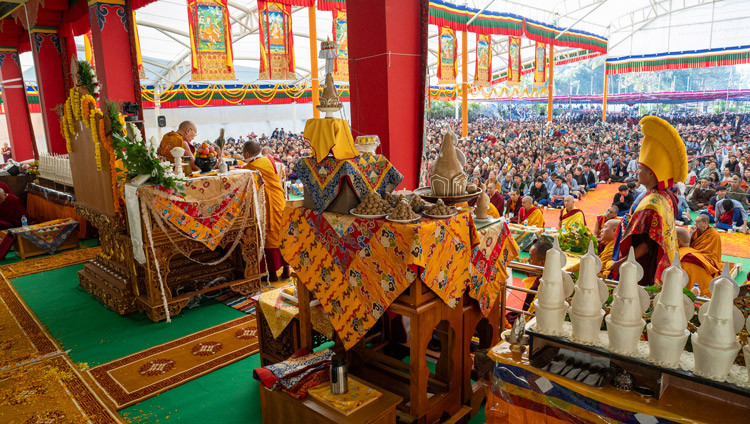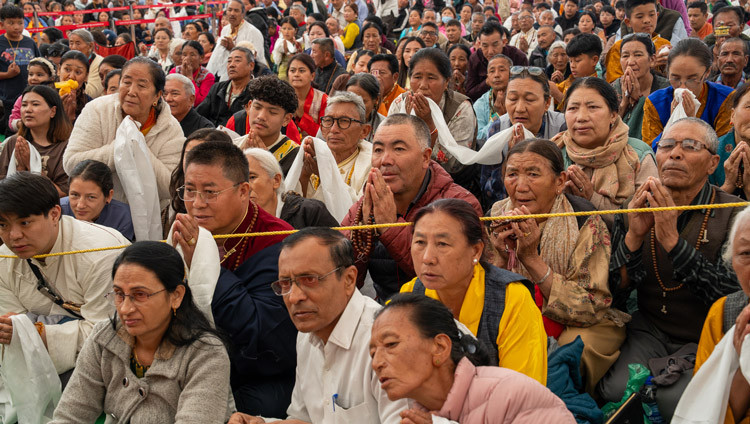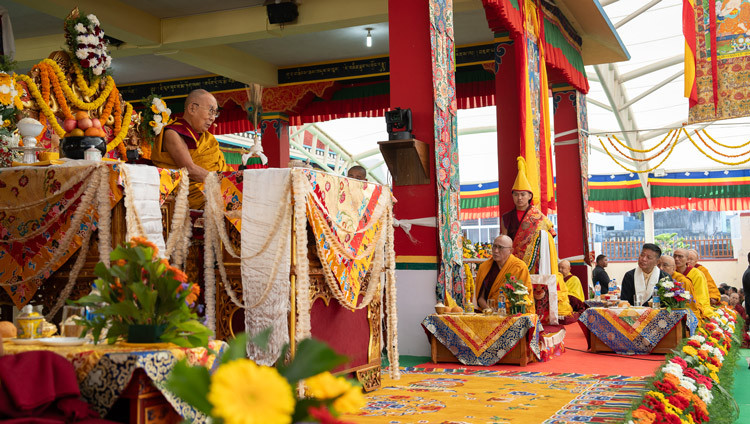Tashi Lhunpo Monastery, Bylakuppé, Karnataka, India - Today, His Holiness the Dalai Lama was to give a Long-Life Empowerment based on White Tara, the Wishfulfilling Wheel, entitled ‘A Stream of Nectar of Immortality’ in the debate yard of Tashi Lhunpo Monastery. The ritual was composed by Takdak Rinpoché, Ngawang Sungrab Thutop, who was His Holiness’s Regent and Tutor.

Monks and nuns filled the temple, while more monks, nuns and lay-people sat in the debate yard under a huge awning. An estimated 25000 people gathered to receive the empowerment, with many Tibetans coming from other settlements in Karnataka. His Holiness rode in a golf cart down from the temple and walked to the throne. Once he was seated, the prayer of the ‘Three Continuums’ was recited, tea, bread and ceremonial sweet rice were distributed, and verses to offer and bless them were said.
His Holiness addressed the assembly: “Today, we are facing all kinds of difficulties and this visit to Bylakuppé is coming to an end, so, I thought it would be auspicious if I were to give a Long-Life Empowerment. That is what I’m going to do. As far as my own lifespan is concerned, I’ve had indications in my dreams that I could live to be 110, but for the time being this empowerment will make an auspicious conclusion.
“This empowerment is in relation to White Tara with whom we have strong karmic connections. A large number of people have gathered here intent on doing Dharma practice not just seeking to improve their name and fame. Therefore, I will be giving this White Tara Empowerment as an auspicious conclusion of this visit.”
“In the last few days, we have engaged in powerful spiritual practice such that if the Buddha were watching us, he would be pleased. This is quite clear.
“Not long ago when I was taking part in a meeting at the Thai Temple in Bodhgaya, I had a clear vision of the Buddha before me. He beckoned to me so I approached him with great respect and I felt he was very kindly disposed towards me. I was gratified that he showed such extraordinary compassion towards meand that he seemed pleased with me.

“The Buddha Dharma has spread around the world, reaching places that historically had no previous connection with Buddhism. I feel I have made some contribution to this.
“In the early part of my life, I was able to study with my Tutors and as a result I have been equipped to make my life meaningful. I am someone who was born in Do-mé, Amdo, and when I was a child my mother and my grandmothers were very kind to me. My family awoke my interest in spiritual practice. When I was about three of four years old, I visited Kumbum Monastery where I learned to recite the mantra Om ara patsa nadhi by following the example of the young monks I saw there. Since then, I’ve been able to create some imprint for the practice of the Dharma in my mind.
“The letters A, Ka and Ma that were displayed in the surface of the Lhamo Latso Lake were among the factors that resulted in my being placed on the throne of the Dalai Lamas. So, not as a result of anything I have done, but due to strong karmic links and past prayers I took up that responsibility. Consequently, people from Central Tibet have shown me their admiration, but so too have people from the Amdo and Dho-tö regions.
“The best part of my life began when I met the two tutors with whom I studied Buddhist philosophy and practice, as well as logic and debate. With their encouragement I memorized Maitreya’s ‘Ornament for Clear Realization’ (Abhisamayalankara) and Chandrakirti’s ‘Entering into the Middle Way’ (Madhyamakavatara). I then received succinct explanations of these texts point by point from them. Accordingly, I feel my human life has been worthwhile.
“When upheaval took place in Lhasa, I made prayers before the Mahakala statue at Norbulingka. I also performed a dough-ball divination before the thangka of Palden Lhamo that I carry with me wherever I go to clarify what I should do. According to the indications I received I left Norbulingka under cover of darkness and escaped. The positive result has been that I was able to reach this free country and meet all kinds of people I would otherwise not have known. What’s more, in places where the name ‘Dalai Lama’ was previously unknown, it has come to be known and admired. Therefore, I feel this precious human life has been worthwhile.
“I will continue to engage in the practice of Dharma by keeping a pure morality and pursuing the practice of tantra as well. In addition, I meditate. Every morning when I wake, I meditate on the awakening mind of bodhichitta and the view of emptiness. I’ve done this every day, trying to live the life of a spiritual person. I have also made many friends among people who were not necessarily interested in Buddhism.

“So, I spent my younger years in Tibet and then came into exile, which is where I have lived most of my life. As I’ve already said, indications in my dreams suggest that I will live to be 110 or so.” Applause rippled through the audience.
“I am someone who came from Siling where the people are generally considered to be quite stern and tough. I feel I have not made that mistake because I have been so involved with the teachings of the Buddha.
“Today, I’m going to give a Long Life Empowerment. First of all, I need to undertake certain preparatory practices. While I do that, please recite Tara’s mantra together.”
Resuming his address to the crowd, His Holiness advised:
“Having found this precious human life, we have to make it meaningful. To do so, we require the complete teaching of the Buddha and to be able to engage in the Three Trainings—ethics, concentration and wisdom. If we are to do that well, we need to have a long life. And we can prolong our lives by relying on a deity like Arya Tara, who has vowed to take care of those who follow the Kadam Tradition.
“All the four tantras are to be practised in the context of bodhichitta, so first of all you have to take the Bodhisattva vow. Without a bodhichitta motivation tantric practice could be misdirected. Whatever tantric practice you do, it must be founded on bodhichitta, the altruistic wish to be of benefit to others. This is the approach I take. Right from the moment I wake up, I generate bodhichitta. Even at the end of the day, I never forget bodhichitta. I go to sleep with mindfulness of bodhichitta. You think to yourself that you will engage in whatever practices you do for the benefit of all sentient beings. In this way you live your life in the service of others.”
His Holiness led the assembly through the verses for generating bodhichitta and taking the Bodhisattva vows. He then proceeded to go through the stages of the empowerment, advising the disciples to imagine themselves dissolving into emptiness. From that, they imagined arising in the form of White Tara.
“As I’ve already mentioned, every morning when I wake I meditate on bodhichitta and the view of emptiness. In my daily life I try to direct my mind towards these two practices that are also known as method and wisdom. Imbued with these two practices on a daily basis, through the days, weeks, months and years of my life I familiarize my mind with bodhichitta and emptiness. It’s not just a matter of reciting verses and prayers, but of making these principals the very core of my practice. In this way we can make our lives meaningful.”
When the empowerment was complete, His Holiness encouraged the disciples to feel delighted. He advised them from now on to take White Tara, the Wish-fulfilling Wheel to be their tutelary deity.
The congregation offered a thanksgiving mandala and the occasion was brought to an end with a recitation of the ‘Prayer of the Words of Truth’ and a series of dedication prayers. Smiling and waving to members of the congregation as he rode in a golf-cart through the debate yard and up to the temple veranda, His Holiness returned to his rooms.












